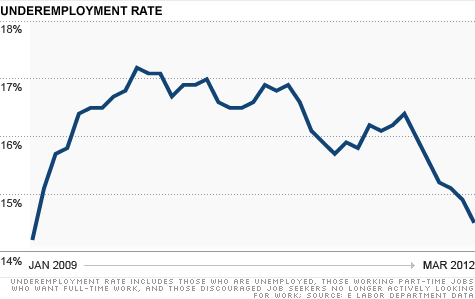
NEW YORK (CNNMoney) -- Friday's March jobs report was widely seen as a big disappointment, but there was one key aspect in it that showed a big improvement.
The so-called underemployment rate, which counts jobless people looking for work, part-time workers who need full-time jobs and discouraged job seekers, fell to a three-year low of 14.5% from 14.9% in February.
When that rate falls, it's a sign not only of less economic pain, but also that the economy is operating closer to full capacity, said Heidi Shierholz, labor economist with the Economic Policy Institute, a liberal think tank.
"When that rate is lower, it is better, better both for workers and the economy," she said.
The underemployment rate reached a record high of 17.2% in November 2009.
Then two years of slow, uneven improvement followed, as the economy slowly mended. But in October of 2011 things began to rapidly improve.
March's underemployment rate is the best reading since just before President Obama took office in January 2009.
Fewer frustrated baristas: Much of the improvement came because the number of workers who want full-time jobs but who are stuck working part time fell by 447,000 to 7.6 million. It's the sixth-biggest monthly drop on record.
"That's a big drop and that's unambiguous good news," said Shierholz.
In addition, the number of unemployed, as well as the number of discouraged workers, also both declined.
There are 12.7 million unemployed job seekers, and about 2.4 million more who say they want to work but are no longer counted in the labor force since they've stopped looking. Those readings fell by a combined 389,000 in March, another sign of less economic desperation.
The more widely followed unemployment rate showed only modest improvement in March to 8.2% from 8.3%. But that was discounted by many, since it was driven by 333,000 people dropping out of the labor force.
Funky number: Normally when there's a significant drop in the size of the labor force, it's because of an increase in discouraged job seekers. But that's not what happened in March, and it raised questions for which economists didn't have any simple answers on Friday.
"It would be easy to characterize the [drop in the labor force] as a sign that disillusioned job seekers are giving up again, but this is a volatile series," said Paul Ashworth, chief U.S. economist for Capital Economics.
He said March's drop in the labor force was offset by the more than 700,000 gain in that reading the two previous months as some who had left it started looking for -- or finding -- jobs again. ![]()
| Overnight Avg Rate | Latest | Change | Last Week |
|---|---|---|---|
| 30 yr fixed | 3.80% | 3.88% | |
| 15 yr fixed | 3.20% | 3.23% | |
| 5/1 ARM | 3.84% | 3.88% | |
| 30 yr refi | 3.82% | 3.93% | |
| 15 yr refi | 3.20% | 3.23% |
Today's featured rates:
| Latest Report | Next Update |
|---|---|
| Home prices | Aug 28 |
| Consumer confidence | Aug 28 |
| GDP | Aug 29 |
| Manufacturing (ISM) | Sept 4 |
| Jobs | Sept 7 |
| Inflation (CPI) | Sept 14 |
| Retail sales | Sept 14 |